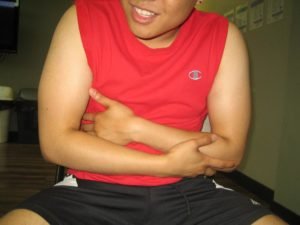During intussusception, one intestinal segment glides into another. The involved sections impede the bowel and hinder the flow of blood.
This is the most prevalent cause of blockage of the intestines in children between 3 months up to 3 years of age. Take note that boys are more affected than girls. In most instances, the cause could not be determined.
Intussusception seldom affects older children which is triggered by something present in the intestine such as a tumor, polyp or Meckel diverticulum. Oftentimes, the sliding segments return to their normal form without requiring treatment. If not, these telescoping segments obstruct the intestine and seal off the flow of blood to the affected region. In case a region of the intestine dies, small-sized holes develop which enables bacteria to enter the abdominal cavity which results to a serious infection.
What are the indications?

Intussusception typically results to episodes of stomach pain and vomiting that occur abruptly to a child who is otherwise healthy. These episodes last for 15-20 minutes. Initially, the child appears well between the episodes.
After some time, as the ischemia develops, the pain becomes constant and the child becomes irritable and/or lethargic while some pass currant jelly-like stools or fever. Oftentimes, the doctor can feel a sausage-shaped mass in the abdominal region when intussusception is located.
Management
The doctor might suspect intussusception based the symptoms and physical examination. An ultrasonography might be requested to confirm a diagnosis. If this test confirms the condition, an air enema is carried out.
During air enema, the doctor introduces air into the rectum of the child via a small tube and an X-ray is performed. The pressure of the air typically drives the telescoping region of the intestine back into its proper place. An X-ray will reveal if the procedure was successful. If successful, the child is sent home after staying overnight in a hospital. Parents should be instructed to monitor for any symptoms since the condition can recur in the next 1-2 days.
Once intussusception is fixed using air enema and not using a surgical procedure, it has the tendency to recur in 5-10% of children. It is important to note that surgery is required if the child shows indications of intestinal perforation, if air enema is not effective in fixing the condition or if the intussusception recurs. If there is recurrence, surgery is performed not only to fix the condition but also check for the presence of a tumor, polyp or other irregularities that might be the reason why intussusception recurred in the first place.
